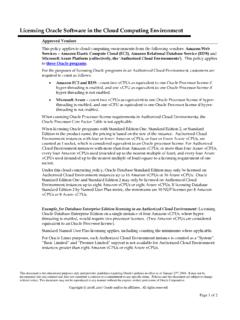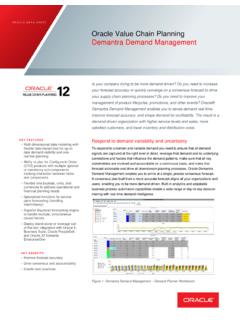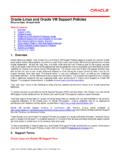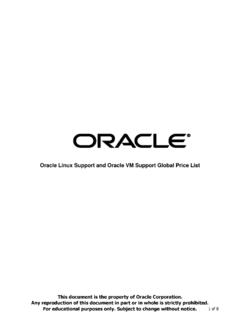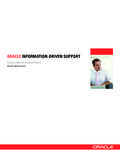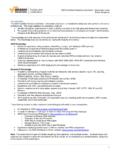Transcription of Improving Logistics & Transportation Perfromance with …
1 Improving Logistics & Transportation performance with Big Data Architect's Guide and Reference architecture Introduction oracle ENTERPRISE ARCHITECT URE WHITE PAPER | FEBRUARY 2015. Disclaimer The following is intended to outline our general product direction. It is intended for information purposes only, and may not be incorporated into any contract. It is not a commitment to deliver any material, code, or functionality, and should not be relied upon in making purchasing decisions. The development, release, and timing of any features or functionality described for oracle 's products remains at the sole discretion of oracle . oracle ENTERPRISE architecture WHITE PAPER Improving Logistics & Transportation performance WITH BIG DATA. Table of Contents Executive Summary 1. Key Business Challenges 2. Where to Find Business Cases that Justify Projects 3. Establishing an Architectural Pattern 5.
2 IT Operational ETL Efficiency 8. oracle Products in the Information architecture 9. Additional Data Management System Considerations 12. Extending the architecture to the Internet of Things 14. Keys to Success 17. Final Considerations 19. oracle ENTERPRISE architecture WHITE PAPER Improving Logistics & Transportation performance WITH BIG DATA. Executive Summary The ability to access, analyze, and manage vast volumes of data while rapidly evolving the Information architecture has long been critical to Logistics management and Transportation companies as they improve business efficiency and performance . While operational efficiency and favorable customer experience and differentiation remain keys to success, anticipating demand and optimizing the routing of goods and services also helps to maximize overall profitability. As Logistics management and Transportation networks become larger, more complex and driven by demands for more exacting service levels, the type of data that is managed also becomes more complex.
3 Today, these data sources can include: Traditional enterprise data from operational systems Traffic & weather data from sensors, monitors and forecast systems Vehicle diagnostics, driving patterns, and location information Financial business forecasts Advertising response data Web site browsing pattern data Social media data The rate that this data is generated is rapidly increasing leading to higher rates of consumption by the business analysts who crave such information. This increase in data velocity and sources naturally drives an increase in aggregate data volumes. Business analysts want more data to be ingested at higher rates, stored longer and want to analyze it faster. Big Data solutions help to enable Logistics and Transportation companies to meet these requirements. This paper provides an overview for the adoption of Big Data and analytic capabilities as part of a next-generation architecture that can meet the needs in the dynamic Logistics and Transportation market.
4 This white paper also presents a reference architecture introduction. The approach and guidance offered is the byproduct of hundreds of customer projects and highlights the decisions that customers faced in the course of their architecture planning and implementations. oracle 's advising architects work across many industries and government agencies and have developed standardized methodology based on enterprise architecture best practices. oracle 's enterprise architecture approach and framework are articulated in the oracle architecture Development Process (OADP) and the oracle Enterprise architecture Framework (OEAF). 1 | oracle ENTERPRISE architecture WHITE PAPER Improving Logistics & Transportation PEFROMANCE WITH BIG DATA. Key Business Challenges Companies focused on logistic management and Transportation historically used data warehouses and business intelligence tools to report on and analyze customer behavior, optimize operations, and build advanced routing solutions.
5 By deploying Big Data Management Systems that include data reservoirs (featuring Hadoop and / or NoSQL Databases), greater benefits in these areas can be achieved and the business can become more agile. Improving Customer Partnerships & Levels of Service Logistics management and Transportation companies seek to differentiate themselves by becoming a reliable partner in the delivery of goods and services. When successful, they are often seen as delivering a critical portion of the supply chain. They must deliver in a predictable and safe manner and offer transparency into the delivery process. As business needs change over time, they must also intelligently forecast the likely impact so as to have the right transport vehicles, crew and facilities available. Hence, predictive analytics has an important role in assuring proper plans are made. As sensors become more prevalent in Transportation vehicles, shipping, and throughout the supply chain, they can provide data enabling greater transparency than has ever been possible.
6 Such data will dwarf today's data warehouses and require Big Data Management systems for processing and reporting. Improving Operational Efficiency Predictive analytics is typically used with data warehouse solutions today to optimize routing of vehicles, crew and goods. Such routing is fundamental to providing the lowest possible cost of Transportation to customers while maintaining margins. It is also critical for understanding potential maintenance challenges and safety issues. Sensor driven data will increasingly provide more information about the vehicles and goods. In some cases, monitoring this data and taking automated actions (such as stopping a locomotive too close to another train) will be mandated by government regulations. However, there is also an opportunity to better understand when maintenance needs to occur and, by monitoring the changing state of key components in near real-time, affording even greater efficiencies and cost savings.
7 So predictive analytics solutions deployed across Big Data Management Systems (including Hadoop) will likely become common practice to increase overall safety, reliability, understand potential warranty issues, and reduce cost. 2 | oracle ENTERPRISE architecture WHITE PAPER Improving Logistics & Transportation performance WITH BIG DATA. Where to Find Business Cases that Justify Projects Many existing business capabilities can be enhanced when more and varied data becomes part of the Information architecture . IT organizations at Logistics management and Transportation companies typically work with their lines of business to build solutions that deliver the following when defining Big Data projects: 1) Accurate Business Demand Planning: Network resource planners need to accurately forecast future business demand to assure they have the right fleet resources and crews in the right place to meet promised delivery schedules.
8 They also need to assure they have the right inventory in the right distribution centers and warehouses. 2) Route Optimization: The key to on-time delivery and optimal load factors is optimal crew and equipment routing. Airlines, trucking companies, and railroads need to understand the implications of changing weather conditions, missed connections, crew work time limits, maintenance schedules, and a host of other factors. Sensors are becoming a significant new source of critical data. Telematics can be applied to insurance to introduce new data monetization opportunities. The claims-to-premiums ratio can be reduced by analyzing risk profiles based on real- time driving statistics for people. Also, additional location based services can be provided based on routing and route optimization. 3) Increased Customer Wallet Share: Customer service professionals must deliver goods in time to meet service level agreements and be seen as an integrated partner in supply chains and delivery.
9 Where customer needs go outside the network, partnerships become critical to offering a more complete solution. 4) Risk Analysis: Logistics companies must understand risk associated with lengthy and complicated crew work schedules and potential losses caused when perishable items are delayed in delivery or subject to temperature extremes, or when items are mishandled and damaged. Vehicle and driver risk analysis based on sensor and geo data will improve driver safety and reduce warranty costs by avoiding potential costly recalls. 5) IT operational efficiency: Not unique to Logistics management and Transportation companies and rarely driven from the lines of business (but a possible reason for embarking on extended architectures that include Hadoop) is the need to move data staging and transformation to a schema-less platform for more efficient processing and leveraging of IT resources.
10 IT operational efficiency is often difficult to prove but is sometimes an initial justification that IT organizations gravitate toward when deploying these types of solutions. On the next page, we show a table that summarizes several typical business challenges in Logistics management and Transportation companies and illustrates the opportunity for new or enhanced business capability when adding new analytic capabilities. 3 | oracle ENTERPRISE architecture WHITE PAPER Improving Logistics & Transportation performance WITH BIG DATA. TABLE 1 Logistics & Transportation FUNCTIONAL AREAS, BUSINESS CHALLENGES & OPPORTUNITIES. FUNCTIONAL AREA BUSINESS CHALLENGE OPPORTUNITY. Distribution Center & Warehouse Properly sized and located distribution Increased inventory turnover Management centers and warehouses Decreased inventory write-downs Consistent available floor space Consistent time to delivery Reduced stock moves to centers Network Resource Planning Ability to scale network up or down based Accurate demand forecasting on demand Optimal fleet utilization Optimal driver /crew availability Improve safety Route Optimization Most optimal pick-up and delivery Predictable time to delivery Optimize fuel utilization Account for traffic conditions Reduce mileage /maximize load Customer service & loyalty Service innovation and differentiation from Improved customer satisfaction competition leading to repeat business Extended network partnerships Service level satisfaction Reduced cost of service Promotions and marketing Optimal spending on promotions to
